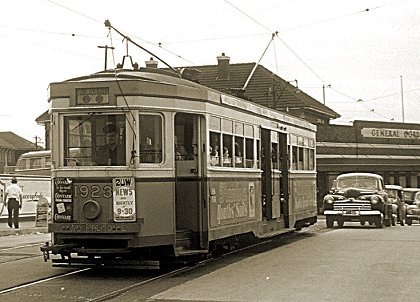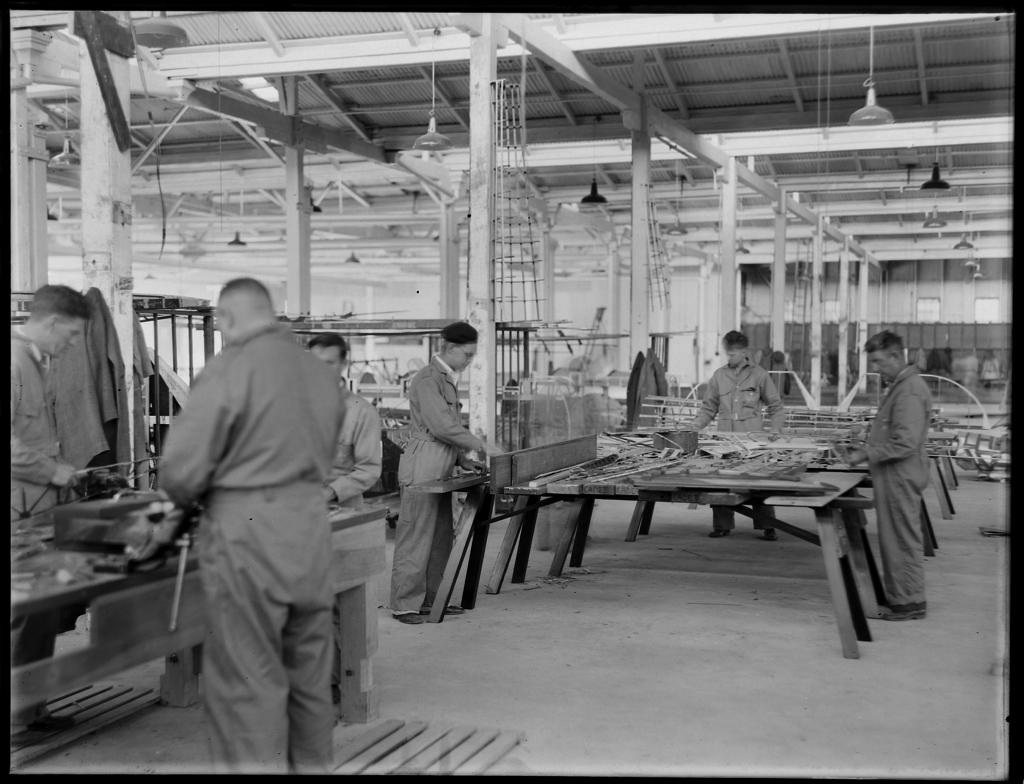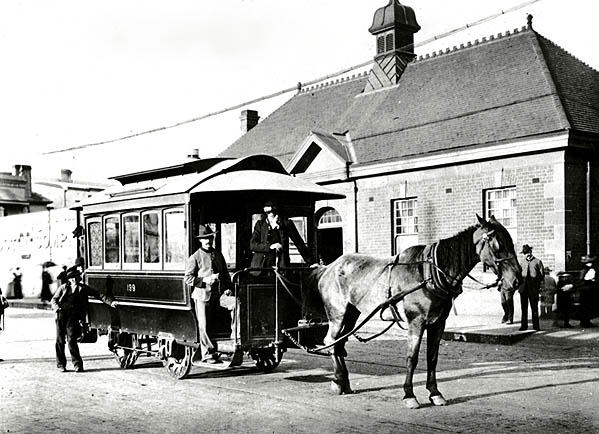|
Sydney R1-Class Tram
The R1-class trams were a class of trams operated on the Sydney tram network. Their design was a development of the R class. History When Clyde Engineering were delivering the last of the R class in 1935, it was decided to modify the final five to a design with a reduced drop-centre, eight more seats, no internal partitions, and one less door each side. These modified trams were classified as R1 class, and a further 50 were ordered from Clyde. In the late 1940s, a further 250 were ordered from Commonwealth Engineering. Steel shortages delayed their construction, with the first not delivered until September 1950. During construction the order was reduced to 100, with the last delivered to North Sydney depot on 17 September 1953. The original five tramcars modified in 1935 (numbers 1933 to 1937) could be distinguished from later production runs by their side windows (which indicated the original door spacing for the R class) and the underframe which was built to accommodate a l ... [...More Info...] [...Related Items...] OR: [Wikipedia] [Google] [Baidu] |
Sydney Showground (Moore Park)
The former Sydney Showground (Moore Park) at Moore Park was the site of the Sydney Royal Easter Show in New South Wales, Australia from 1882 until 1997, when the Show was moved to the new Sydney Showground at Sydney Olympic Park, which was built for the Sydney 2000 Olympics. The old site was then leased to News Corporation on a 99-year lease from the Government of New South Wales to be used for the site of Disney Studios Australia (formerly Fox Studios Australia), and is now part of The Entertainment Quarter. History In 1811, Governor Macquarie proclaimed Sydney's second common, an area of . In 1882, The Agricultural Society established its grounds within the site, which henceforth became the venue of the Sydney Royal Easter Show—an annual expression of national pride in Australian produce and industry. The period from 1902 to 1919 saw the expansion of the showgrounds to the south. From 1920 to 1937, the grounds were further expanded to the north, with the addition ... [...More Info...] [...Related Items...] OR: [Wikipedia] [Google] [Baidu] |
North Sydney, New South Wales
North Sydney is a suburb and major commercial district on the Lower North Shore of Sydney, Australia. North Sydney is located 3 kilometres north of the Sydney central business district and is the administrative centre for the local government area of North Sydney Council. History The Indigenous people on the southern side of Port Jackson (Sydney Harbour) called the north side ''warung'' which meant ''the other side'', while those on the northern side used the same name to describe the southern side. The first name used by European settlers was ''Hunterhill'', named after a property owned by Thomas Muir of Huntershill (1765–1799), a Scottish political reformer. He purchased land in 1794 near the location where the north pylon of the Sydney Harbour Bridge is now located, and built a house which he named after his childhood home. This area north to Gore Hill became known as St Leonards. The township of St Leonards was laid out in 1836 in what is now North Sydney, bound ... [...More Info...] [...Related Items...] OR: [Wikipedia] [Google] [Baidu] |
NewsLocal
NewsLocal is a subsidiary of News Corp Australia that operates its community newspapers in New South Wales. It used to be Cumberland-Courier Community Newspapers. In April 2020, Newscorp announced they would suspend print publication of a number of local and regional newspapers due to the impact of the coronavirus pandemic in Australia. Current newspapers are: * Blacktown Advocate * Canterbury-Bankstown Express * Central (newspaper) * Express Advocate Gosford Edition * Express Advocate Wyong Edition * Fairfield Advance * Hills Shire Times * Hornsby & Upper North Shore Advocate * Inner West Courier * Liverpool Leader * Macarthur Chronicle Camden Edition * Macarthur Chronicle Campbelltown Edition * Macarthur Chronicle Wollondilly Edition * Manly Daily * Mosman Daily * Mt Druitt Standard * North Shore Times * Northern District Times * Northside (newspaper) * Parramatta Advertiser * Penrith Press * Southern Courier * Village Voice - Balmain * Wentworth Courier NewsL ... [...More Info...] [...Related Items...] OR: [Wikipedia] [Google] [Baidu] |
Rozelle Tram Depot
Rozelle Tram Depot is a former tram storage and operations centre that was part of the Sydney tram network. It is the largest remaining tram depot in Sydney. The depot was turned into a food-centric retail complex that opened in September 2016. History Rozelle Tram Depot opened on 17 April 1904, working in conjunction with Newtown and Ultimo depots operating trams on the western, south-western and Ryde tram routes. The depot was originally accessed by a reserved track from Glebe which ran along what is now known as Minogue Crescent. Access to the depot was controlled by a signal box situated near the staff waiting room which also served as a changeover point for drivers. Constructed in stages from 1904 the depot was a 25 road car shed accommodating 96 carriages, this was gradually increased to 125 by 1907. Construction of the second half of the depot in that same year saw the depot cater for an additional 70 trams. From 1918 depot capacity was increased to 200 tram cars. ... [...More Info...] [...Related Items...] OR: [Wikipedia] [Google] [Baidu] |
Tramway Museum, St Kilda
The Tramway Museum, St Kilda is Australia's principal museum of the 19th and 20th century trams of Adelaide, South Australia. It is situated at St Kilda, north of the centre of Adelaide. It is operated by the Australian Electric Transport Museum (SA) Inc., a not-for-profit volunteer organisation affiliated with the Council of Tramway Museums of Australasia. It is dedicated to the study, conservation and restoration of trams that were used in Adelaide or built there, and likewise with a small bus and trolleybus collection. Trams provide rides for visitors along a 1.6 km (1.0 mi) purpose-built track between the museum and a large adventure playground. Scope The museum is one of very few transport museums in the world holding at least one example of every principal tram type to have been in service on a city street system.Technically, two tram types are unrepresented, but their omission is trivial since both were rebuilds of Type B trams, namely Type A1, of which ... [...More Info...] [...Related Items...] OR: [Wikipedia] [Google] [Baidu] |
Sydney Tramway Museum
The Sydney Tramway Museum (operated by the South Pacific Electric Railway) is Australia's oldest tramway museum and the largest in the southern hemisphere. It is located at Loftus in the southern suburbs of Sydney. History Construction of the museum at its original site on the edge of the Royal National Park commenced in August 1956. It was officially opened in March 1965 by NSW Deputy Premier Pat Hills. The facilities were basic, initially a four-track shed built with second hand materials and approximately 800 metres of running track. In 1975, the Government of New South Wales approved the museum moving to a new site across the Princes Highway adjacent to Loftus railway station. Construction commenced in April 1980, with the first trams transferred from the old site in November 1982. It officially opened on 19 March 1988. The former Railway Square tramway shelter that had been disassembled in 1973 was reassembled. The last tram left the Royal National Park in May 1989. I ... [...More Info...] [...Related Items...] OR: [Wikipedia] [Google] [Baidu] |
Randwick Bus Depot
Randwick Bus Depot is a bus depot in the Sydney suburb of Randwick operated by Transdev John Holland. History In 1881 the Randwick Tramway Workshops were established on the corner of Darley Road and King Street, Randwick as the main workshops for the Sydney tram network. It also had a depot attached. In 1902 the workshops were renamed the Randwick Tramway Workshops. The workshops grew rapidly to become one of Sydney's largest engineering establishments peaking in the 1920s. and performed all heavy maintenance on the fleet, Randwick Workshops were also instrumental for the construction of the L and LP classes that were completely rebuilt from the F class. O/P class, The PR and 2 of the PR1 classes were all converted by Randwick workshops out of trams that had been involved either in accidents or required major overhaul. During World War I and World War II workers from the Tramways Workshops were diverted to manufacturing armaments and artillery. The 1917 General Strike b ... [...More Info...] [...Related Items...] OR: [Wikipedia] [Google] [Baidu] |
Petersham, New South Wales
Petersham is a suburb in the Inner West of Sydney, in the state of New South Wales, Australia. Petersham is located 6 kilometres south-west of the Sydney central business district, in the Local government in Australia, local government area of Inner West Council. Petersham is known for its extensive Portugal, Portuguese commercial offerings, with many Portuguese businesses and restaurants, although only 156 (1.9%) of the population was actually born in Portugal. Petersham is bordered by the suburbs of Leichhardt, New South Wales, Leichhardt to the north, Stanmore, New South Wales, Stanmore to the east, Marrickville, New South Wales, Marrickville to the south and Lewisham, New South Wales, Lewisham to the west. Taverner's Hill, named after Fred Taverner, is a locality in the western part of the suburb. History Major Francis Grose (Lieutenant-Governor), Francis Grose sent workmen to the area in 1793 to clear the bush and plant corn and wheat. He named the area Peters-Ham or P ... [...More Info...] [...Related Items...] OR: [Wikipedia] [Google] [Baidu] |
Sydney R-Class Tram
The R-class trams were a class of drop-centre saloon car type trams operated on the Sydney tram network. History Class leader 1738 was unveiled in a ceremony at Randwick Tramway Workshops on 29 September 1933. All 195 cars were in service by mid-1935. Passengers were accommodated in two saloons featuring 16 tip-over upholstered seats in each, plus wooden seating for 16 in the centre section. The relatively low seating capacity of only 48 (compared to the older toastrack trams) and their inability to operate in service as multiple units went against the class. The last five of the order for 200 tramcars were altered during construction to a modified design with increased seating capacity, becoming prototypes for the R1 class, resulting in only 195 being completed to the original (R class) design. Rushcutters Bay was the first depot to be allocated trams, Fort Macquarie followed next, then Waverley, North Sydney and Newtown. Ultimo received its first R cars in 1940, with Ro ... [...More Info...] [...Related Items...] OR: [Wikipedia] [Google] [Baidu] |
Clyde Engineering
Clyde Engineering was an Australian manufacturer of locomotives, rolling stock, and other industrial products. It was founded in September 1898 by a syndicate of Sydney businessmen buying the Granville factory of timber merchants Hudson Brothers. The company won contracts for railway rolling stock, a sewerage system, trams and agricultural machinery. In 1907 it won its first contract for steam locomotives for the New South Wales Government Railways. By 1923 it had 2,200 employees. After contracting during the depression it became a major supplier of munitions during World War II. In 1950 it was awarded the first of many contracts for diesel locomotives by the Commonwealth Railways after it was appointed the Australian licensee for Electro-Motive Diesel products. Apart from building locomotives and rolling stock, Clyde Engineering diversified into telephone and industrial electronic equipment, machine tools, domestic aluminium ware, road making and earth making equipme ... [...More Info...] [...Related Items...] OR: [Wikipedia] [Google] [Baidu] |
Trams In Sydney
The Sydney tramway network served the inner suburbs of Sydney, Australia from 1879 until 1961. In its heyday, it was the largest in Australia, the second largest in the Commonwealth of Nations (after London), and one of the largest in the world. The network was heavily worked, with about 1,600 cars in service at any one time at its peak during the 1930s (cf. about 500 trams in Melbourne today). Patronage peaked in 1945 at 405 million passenger journeys. Its maximum street trackage totalled 291 km (181 miles) in 1923. History Early tramways Sydney's first tram was horse-drawn, running from the old Sydney railway station to Circular Quay along Pitt Street.''The 1861 Pitt Street Tramway and the Contemporary Horse Drawn Railway Proposals'' Wylie, R.F. Australian Railway Historical Society Bulletin, February, 1965 pp21-32 Built in 1861, the design was compromised by the desire to haul railway freight wagons along the line to supply city businesses and return cargo from the ... [...More Info...] [...Related Items...] OR: [Wikipedia] [Google] [Baidu] |
Overhead Line
An overhead line or overhead wire is an electrical cable that is used to transmit electrical energy to electric locomotives, trolleybuses or trams. It is known variously as: * Overhead catenary * Overhead contact system (OCS) * Overhead equipment (OHE) * Overhead line equipment (OLE or OHLE) * Overhead lines (OHL) * Overhead wiring (OHW) * Traction wire * Trolley wire This article follows the International Union of Railways in using the generic term ''overhead line''. An overhead line consists of one or more wires (or rails, particularly in tunnels) situated over rail tracks, raised to a high electrical potential by connection to feeder stations at regular intervals. The feeder stations are usually fed from a high-voltage electrical grid. Overview Electric trains that collect their current from overhead lines use a device such as a pantograph, bow collector or trolley pole. It presses against the underside of the lowest overhead wire, the contact wire. Current colle ... [...More Info...] [...Related Items...] OR: [Wikipedia] [Google] [Baidu] |






.jpg)